By Leen Randell
Updated: Jul 08, 2024
10 Best Herbal Decoctions For Eye Strain

Herbal decoctions for eye strain are a natural remedy that can provide relief from the discomfort and fatigue associated with prolonged screen time, reading, or other visual activities.
These decoctions are made by steeping herbs like chamomile, calendula, and peppermint in hot water to create a soothing liquid that can be applied as an eyewash. By reducing inflammation and relaxing the eyes, herbal decoctions help alleviate eye strain, improving vision clarity and reducing dryness and irritation.
For example, drinking a chamomile decoction has been shown to reduce digital eye fatigue, allowing people to work or read for longer periods without discomfort.
The following article describes in detail the most important decoctions for eye strain, including medicinal properties, parts of herbs to use, and recipes for preparations.
- 1. Bacopa monnieri
- 2. Ginkgo biloba
- 3. Euphrasia officinalis
- 4. Vaccinium myrtillus
- 5. Ribes nigrum
- 6. Hibiscus sabdariffa
- 7. Stevia rebaudiana
- 8. Calendula officinalis
- 9. Tilia europaea
- 10. Achillea millefolium
- What is the best combination of herbal decoctions to use for eye strain?
- What ailments similar to eye strain are treated with herbal decoctions?
1. Bacopa monnieri
Brahmi decoctions helps with eye strain because its bioactive compounds, such as bacosides and saponins, possess adaptogenic properties that promote relaxation and reduce stress.
This in turn alleviates muscle tension and fatigue in the eyes, which is often the root cause of strain and discomfort.
Brahmi's anti-inflammatory and antioxidant effects also help to soothe and protect the delicate tissues of the eyes, further reducing the risk of damage and promoting overall eye health and function.
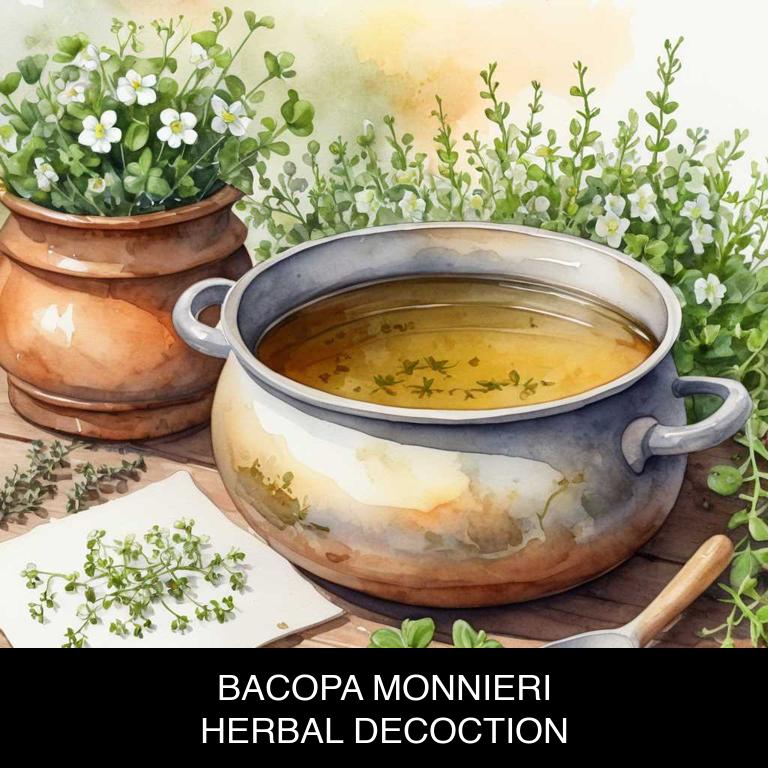
Medicinal Constituents
The list below shows the primary medicinal constituents in Bacopa monnieri decoctions that help with eye strain.
- Bacosides: Bacosides, a group of triterpenoid saponins, help reduce eye strain by possessing anti-inflammatory properties that alleviate oxidative stress and protect the eyes from damage caused by prolonged screen time or other visual strain.
- Bacopaside ii: Bacopaside II, a specific bacoside, aids in reducing eye strain by possessing antioxidant properties that neutralize free radicals and protect the eyes from damage, thereby promoting overall eye health.
- Clerodane diterpenes: Clerodane diterpenes, a type of terpene, help alleviate eye strain by exhibiting anti-inflammatory and antioxidant activities that reduce oxidative stress and promote the regeneration of damaged eye tissues.
Parts Used
The list below shows the primary parts of brahmi used to make decoctions for eye strain.
- Leaves: The leaves of Bacopa monnieri are used to make decoctions for eye strain because they are rich in bacosides, which have been shown to have neuroprotective properties and improve cognitive function.
- Roots: The roots are used to make decoctions for eye strain because they contain a higher concentration of bacosides and other active compounds compared to other parts of the plant.
- Stems: The stems of Bacopa monnieri are used to make decoctions for eye strain because they contain a combination of alkaloids and saponins that may help reduce stress and promote relaxation.
Quick Recipe
The following recipe gives a procedure to make a basic brahmi for eye strain.
- Harvest a quantity of fresh or dried bacopa monnieri leaves and flowers according to the desired dosage.
- Rinse the harvested plant material in a fine mesh strainer under cold running water for 2 minutes.
- Combine the rinsed plant material with 1 quart of boiling water in a heat-resistant container for 5 minutes.
- Strain the decoction through a cheesecloth or a fine mesh strainer into a clean container for 5 minutes.
- Allow the decoction to steep for 30 minutes to 1 hour before consumption to enhance the bioavailability.
2. Ginkgo biloba
Maidenhair tree decoctions helps with eye strain because they contain a unique combination of antioxidants, flavonoids, and saponins that work together to soothe and relax the eyes.
The decoction's anti-inflammatory properties help reduce redness and irritation, while its moisturizing effects ease dryness and discomfort.
Additionally, the herbal compounds have been shown to improve blood flow to the eyes, reducing fatigue and strain caused by prolonged screen time or other visual activities.

Medicinal Constituents
The list below shows the primary medicinal constituents in Ginkgo biloba decoctions that help with eye strain.
- Flavonoids: These compounds help with eye strain by reducing inflammation and improving blood flow to the eyes, which can help alleviate fatigue and discomfort associated with prolonged screen use or other visual activities.
- Terpenoids: These terpenoids have anti-inflammatory properties that can help reduce oxidative stress and inflammation in the eyes, which can contribute to eye strain and discomfort.
- Biflavonoids: These compounds have antioxidant properties that can help protect the eyes from damage caused by free radicals, which can contribute to eye strain and fatigue.
Parts Used
The list below shows the primary parts of maidenhair tree used to make decoctions for eye strain.
- Leaves: They are widely used due to their high flavonoid content and antioxidant properties, which help to reduce eye strain and improve vision.
- Seeds: The seeds contain a compound called bilobalide, which has anti-inflammatory properties that can help to alleviate eye strain and discomfort.
- Barks: The bark of the Ginkgo biloba tree is also used due to its flavonoid content, which can help to improve blood flow to the eyes and reduce eye strain.
Quick Recipe
The following recipe gives a procedure to make a basic maidenhair tree for eye strain.
- Gather 2-4 grams of dried ginkgo biloba leaves and 1 liter of cold water for the decoction.
- Crush the ginkgo biloba leaves into a fine powder using a mortar and pestle.
- Combine the crushed ginkgo biloba powder with the cold water in a saucepan and bring to a boil.
- Reduce the heat to a simmer and let the mixture steep for 30-45 minutes or 2-3 hours.
- Strain the decoction through a cheesecloth or a fine mesh sieve into a clean container.
3. Euphrasia officinalis
Eyebright decoctions helps with eye strain because they provide a natural way to soothe and calm irritated eyes.
The potent antioxidants and flavonoids present in eyebright herbs help to reduce inflammation and relax the muscles surrounding the eyes, alleviating tension and fatigue.
This can lead to improved vision clarity and reduced redness, making eyebright decoctions an effective remedy for individuals who spend extended periods staring at digital screens or engaging in other activities that put a strain on their eyes.
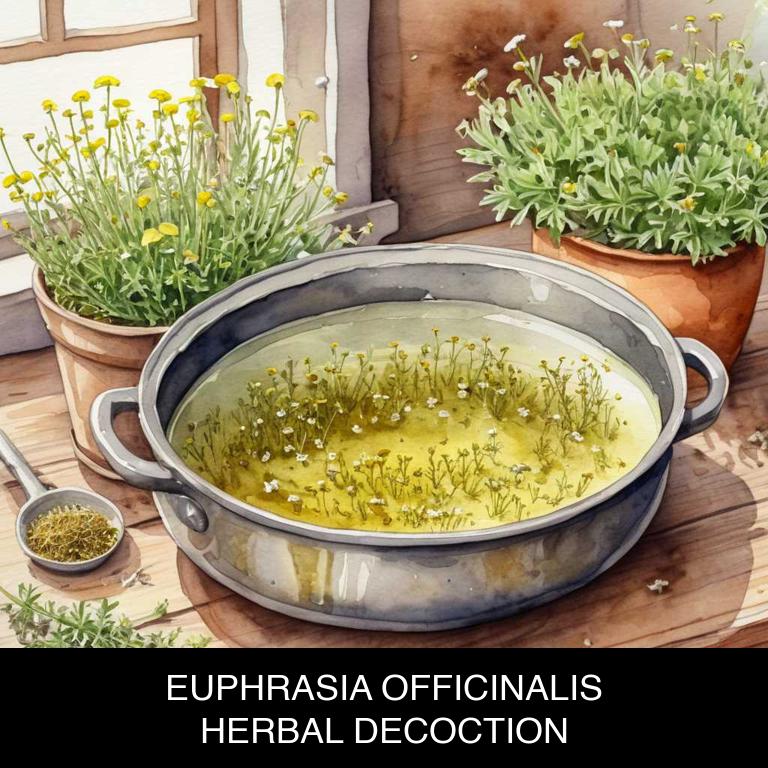
Medicinal Constituents
The list below shows the primary medicinal constituents in Euphrasia officinalis decoctions that help with eye strain.
- Rosmarinic acid: This phenolic compound has anti-inflammatory properties, which help reduce redness and swelling in the eyes associated with eye strain.
- N-feruloyltyramine: This phenylethylamine alkaloid has antioxidant properties, which protect the eyes from damage caused by free radicals and oxidative stress, thereby alleviating eye strain.
- Isorhapontigenin: This phenolic compound has anti-inflammatory and antioxidant properties, which help soothe and calm the eyes, reducing discomfort and fatigue caused by eye strain.
Parts Used
The list below shows the primary parts of eyebright used to make decoctions for eye strain.
- Leaves: They are the primary source of the plant's bioactive compounds, which are responsible for its therapeutic effects.
- Flowers: They are rich in flavonoids and alkaloids, which contribute to their use in treating eye problems and promoting eye health.
- Roots: They contain a unique combination of compounds that, when extracted and used in decoctions, help alleviate eye strain and improve vision.
Quick Recipe
The following recipe gives a procedure to make a basic eyebright for eye strain.
- Harvest 25g of fresh euphrasia officinalis leaves and flowers at the peak of their potency in summer.
- Dry the harvested euphrasia officinalis in a well-ventilated area for 7-10 days to reduce moisture content.
- Grind 5g of dried euphrasia officinalis into a fine powder using a mortar and pestle to enhance extraction.
- Combine 200ml of boiling water with 1g of euphrasia officinalis powder in a heat-resistant glass container.
- Steep the mixture for 10-15 minutes then strain it using a cheesecloth to obtain the final decoction.
4. Vaccinium myrtillus
Blueberry decoctions helps with eye strain because of its potent antioxidant properties.
The anthocyanins and phenolic acids present in blueberries work synergistically to reduce oxidative stress in the eyes, alleviating fatigue and discomfort caused by prolonged screen time or visual tasks.
Additionally, the anti-inflammatory effects of blueberry decoction help to calm and soothe the eye muscles, promoting a sense of relaxation and reducing eye strain's negative impact on overall vision health.
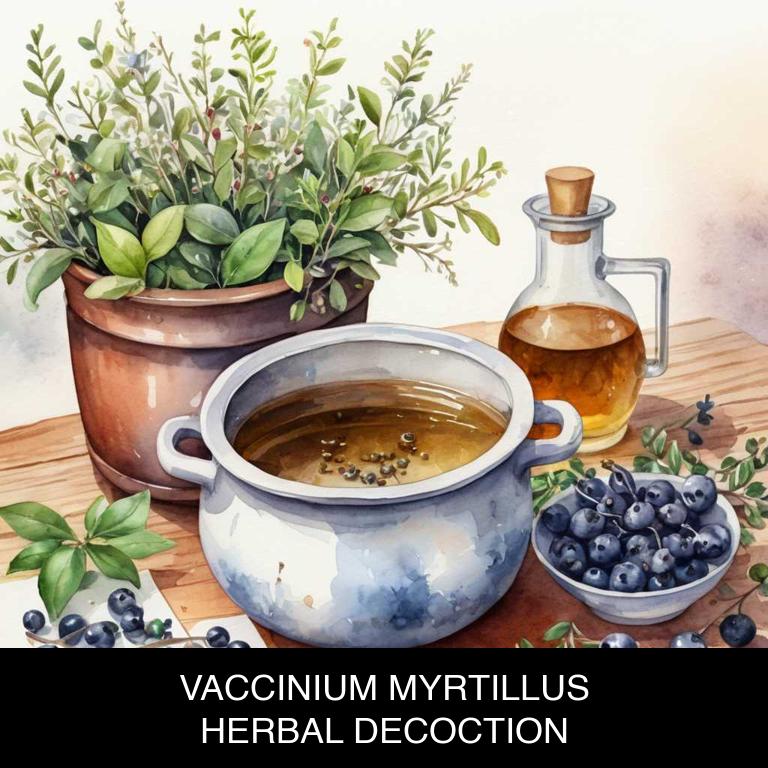
Medicinal Constituents
The list below shows the primary medicinal constituents in Vaccinium myrtillus decoctions that help with eye strain.
- Anthocyanins: These powerful antioxidants help reduce oxidative stress and inflammation in the eyes, alleviating eye strain and promoting overall eye health.
- Quercetin: This flavonoid has anti-inflammatory properties that help soothe and calm the eyes, reducing the discomfort and fatigue associated with eye strain.
- Delphinidin: This anthocyanidin has been shown to have vasoprotective effects, improving blood flow to the eyes and reducing the strain caused by prolonged visual activity.
Parts Used
The list below shows the primary parts of blueberry used to make decoctions for eye strain.
- Leaves: The leaves are the most commonly used part of Vaccinium myrtillus for eye strain decoctions due to their high content of anthocyanins and other antioxidants that help reduce eye fatigue.
- Fruits: The fruits, also known as bilberries, are used to make decoctions for eye strain as they are rich in anthocyanins and other compounds that help to improve eye health and reduce strain.
- Barks: The barks of Vaccinium myrtillus are sometimes used to make decoctions for eye strain as they contain flavonoids and other compounds that may help to reduce inflammation and improve eye health.
Quick Recipe
The following recipe gives a procedure to make a basic blueberry for eye strain.
- Gather 25-30 grams of dried vaccinium myrtillus fruit and 1 liter of water to make decoction.
- Combine the dried vaccinium myrtillus fruit with water in a saucepan and bring to a boil.
- Reduce heat to a simmer and let the mixture cook for 10-15 minutes or until the liquid has reduced by half.
- Strain the decoction through a cheesecloth or a fine mesh sieve into a clean container to remove solids.
- Allow the decoction to cool and refrigerate it for up to 3 days before use as needed.
5. Ribes nigrum
Blackcurrant decoctions helps with eye strain because of its potent antioxidant properties, which work to neutralize free radicals that can damage the eyes.
The decoction's rich flavonoid content, particularly anthocyanins and quercetin, has been shown to reduce inflammation in the eyes, relieving symptoms of dryness, itchiness, and redness associated with prolonged screen time or eye fatigue.
This natural remedy also helps to improve blood flow to the eyes, promoting healthy vision and reducing the risk of age-related macular degeneration.
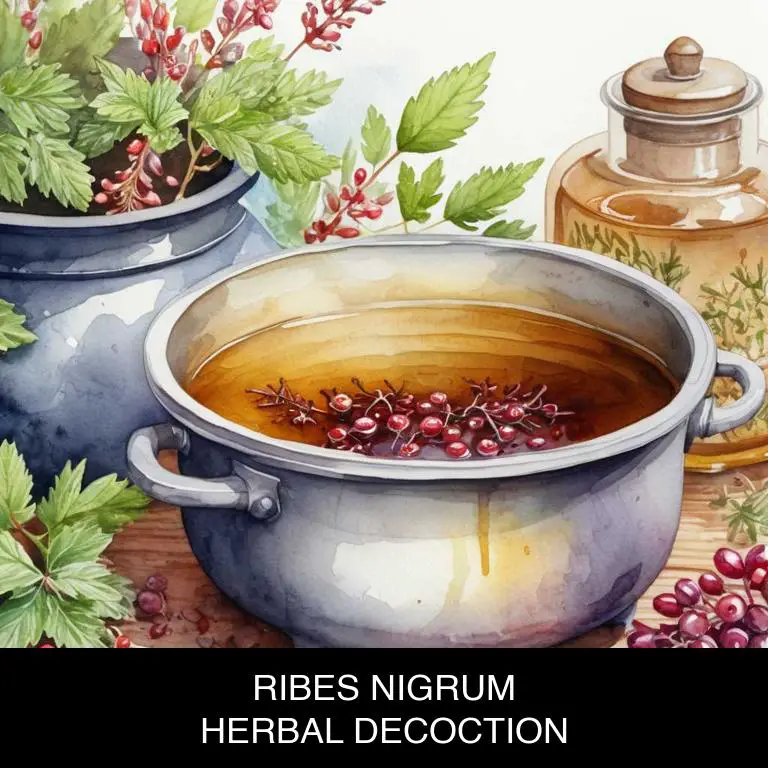
Medicinal Constituents
The list below shows the primary medicinal constituents in Ribes nigrum decoctions that help with eye strain.
- Anthocyanins: These powerful antioxidants help reduce oxidative stress and inflammation in the eyes, alleviating eye strain caused by prolonged screen time or physical activity.
- Quercetin: A flavonoid with anti-inflammatory properties, quercetin helps reduce swelling and irritation in the eyes, providing relief from eye strain and promoting overall eye health.
- Caffeic acid: A polyphenolic compound with antioxidant and anti-inflammatory properties, caffeic acid helps protect the eyes from damage caused by free radicals and oxidative stress, reducing the risk of eye strain.
Parts Used
The list below shows the primary parts of blackcurrant used to make decoctions for eye strain.
- Leaves: Rich in antioxidants and flavonoids, which help reduce inflammation and protect the eyes from oxidative stress.
- Fruits: Contain anthocyanins and other pigments that may help reduce eye strain and improve vision due to their antioxidant properties.
- Flowers: May be used to create a soothing decoction due to their potential anti-inflammatory effects on the eyes.
Quick Recipe
The following recipe gives a procedure to make a basic blackcurrant for eye strain.
- Harvest fresh leaves and stems of ribes nigrum in the early morning for optimal potency.
- Clean the harvested material by gently washing it with cold water to remove dirt.
- Combine 2 teaspoons of dried leaves and stems with 1 cup of boiling water to make decoction.
- Steep the mixture for 5-10 minutes to allow the active compounds to infuse into the water.
- Strain the decoction and discard the solids to obtain the herbal remedy.
6. Hibiscus sabdariffa
Roselle decoctions helps with eye strain because of its unique combination of antioxidants, flavonoids, and vitamins.
The decoction's anti-inflammatory properties help reduce redness and swelling in the eyes, alleviating discomfort caused by prolonged screen time or reading. Additionally, roselle's antioxidant content neutralizes free radicals that can damage the eyes' delicate tissues, promoting healthy vision and reducing fatigue.
As a natural remedy, roselle decoctions provide a soothing and effective solution for relieving eye strain and promoting overall ocular health.
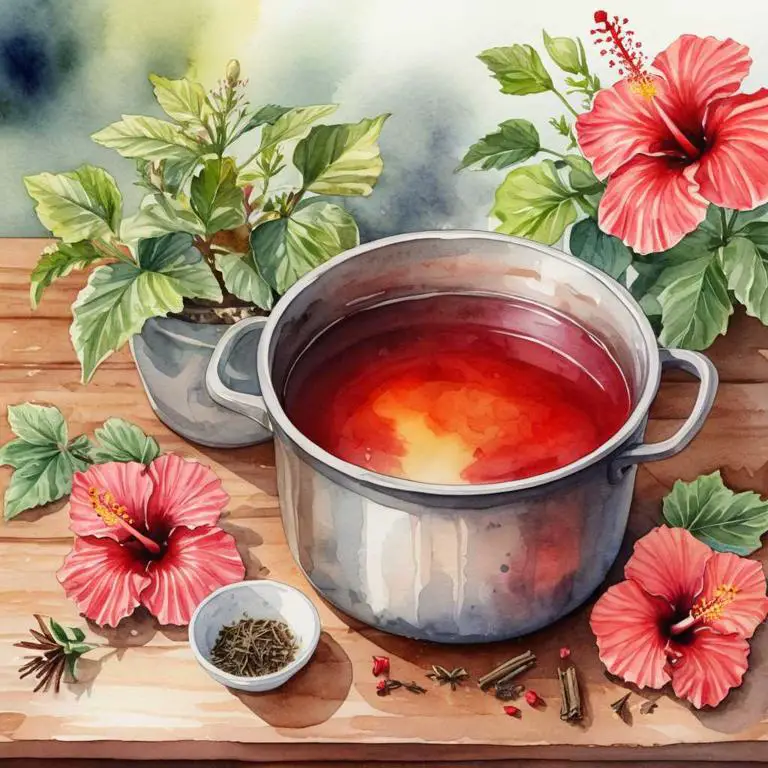
Medicinal Constituents
The list below shows the primary medicinal constituents in Hibiscus sabdariffa decoctions that help with eye strain.
- Anthocyanins: These powerful antioxidants help to reduce oxidative stress and inflammation in the eyes, thereby alleviating eye strain caused by prolonged screen time or other visual activities.
- Mangiferin: A xanthone glycoside, mangiferin has anti-inflammatory and antioxidant properties, which may help to reduce eye strain by protecting the eyes from damage caused by free radicals and promoting healthy vision.
- Saponins: These natural compounds may help to improve blood flow to the eyes, reducing eye strain caused by decreased oxygenation and promoting overall eye health.
Parts Used
The list below shows the primary parts of roselle used to make decoctions for eye strain.
- Flowers: They are commonly used to make decoctions for eye strain due to their anti-inflammatory properties and ability to relax the eyes.
- Leaves: The leaves of Hibiscus sabdariffa are used to create decoctions for eye strain relief, possibly due to their antioxidant and soothing effects.
- Stems: The stems of the plant are also used to make decoctions for eye strain, possibly due to their ability to reduce inflammation and promote relaxation.
Quick Recipe
The following recipe gives a procedure to make a basic roselle for eye strain.
- Harvest 50 grams of dried hibiscus sabdariffa flowers for maximum medicinal benefits.
- Combine the dried flowers with 500 ml of boiling water in a large pot.
- Reduce heat to low and simmer for 10 to 15 minutes to release active compounds.
- Strain the mixture using a cheesecloth or a fine-mesh sieve into a large bowl.
- Store the cooled decoction in an airtight container in the refrigerator for up to 3 days.
7. Stevia rebaudiana
Stevia decoctions helps with eye strain because of its unique properties that soothe and calm the eyes.
The herbal stevia, rich in antioxidants and flavonoids, works to reduce inflammation and promote healthy vision. When consumed as a decoction, it helps to relax the ocular muscles, reducing fatigue and discomfort caused by prolonged screen time or reading.
Additionally, the decoction's anti-inflammatory properties help to alleviate redness and itchiness, providing fast relief from eye strain.
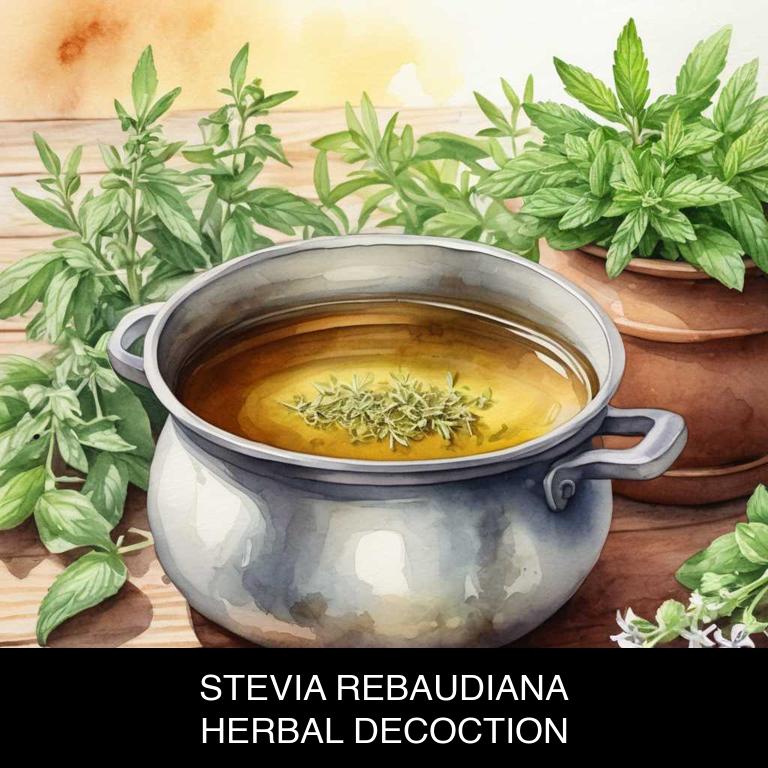
Medicinal Constituents
The list below shows the primary medicinal constituents in Stevia rebaudiana decoctions that help with eye strain.
- Steviol glycosides: These compounds have anti-inflammatory properties, which help reduce swelling and irritation in the eyes, alleviating eye strain.
- Kaempferol: As a flavonoid antioxidant, kaempferol helps protect the eyes from oxidative stress and damage caused by blue light exposure, reducing eye strain and fatigue.
- Quercetin: This flavonoid has anti-inflammatory and antioxidant properties, which help soothe and calm the eyes, reducing eye strain and promoting overall eye health.
Parts Used
The list below shows the primary parts of stevia used to make decoctions for eye strain.
- Leaves: Stevia leaves are used to make decoctions for eye strain because they contain antioxidants and anti-inflammatory compounds that help alleviate eye fatigue.
- Stems: Stevia stems are used to make decoctions for eye strain because they contain flavonoids and saponins that have anti-inflammatory and antioxidant properties, which can reduce eye strain.
- Roots: Stevia roots are used to make decoctions for eye strain because they contain bioactive compounds that have anti-inflammatory and antioxidant effects, which can help soothe and protect the eyes.
Quick Recipe
The following recipe gives a procedure to make a basic stevia for eye strain.
- Harvest stevia rebaudiana leaves in the morning when they are at their highest sugar content.
- Dry stevia rebaudiana leaves in a warm place for 2-3 days or use a food dehydrator at 35 degrees celsius.
- Crush 10-20 grams of dried stevia rebaudiana leaves into a fine powder using a spice grinder.
- Steep 1-2 teaspoons of stevia powder in 1 cup of boiling water for 5-10 minutes to make a decoction.
- Filter the decoction through a cheesecloth or a coffee filter to remove the solids before serving.
8. Calendula officinalis
Pot marigold decoctions helps with eye strain because of its exceptional anti-inflammatory and antioxidant properties.
The decoction's active compounds, such as lutein and zeaxanthin, have been shown to reduce oxidative stress and inflammation in the eyes, which can alleviate symptoms of digital eye fatigue caused by prolonged screen time or reading.
Additionally, the decoction's soothing and calming effects can help relax the ocular muscles, reducing discomfort and promoting overall eye health and visual clarity.

Medicinal Constituents
The list below shows the primary medicinal constituents in Calendula officinalis decoctions that help with eye strain.
- Triterpenoids: These compounds help alleviate eye strain by reducing inflammation and oxidative stress in the eyes.
- Flavonoids: Quercetin has anti-inflammatory properties that help protect the eyes from strain and promote healthy vision.
- Saponins: Saponins in Calendula officinalis have anti-inflammatory and antioxidant effects, which help to reduce eye strain and promote recovery.
Parts Used
The list below shows the primary parts of pot marigold used to make decoctions for eye strain.
- Flowers: The flowers are the most commonly used part due to their high content of bioactive compounds that can help soothe and calm eye strain.
- Leaves: The leaves are utilized for their antioxidant and anti-inflammatory properties, which can aid in reducing eye strain and promoting overall eye health.
- Roots: The roots of Calendula officinalis are used for their potential to reduce inflammation and promote healing, which can be beneficial in addressing underlying causes of eye strain.
Quick Recipe
The following recipe gives a procedure to make a basic pot marigold for eye strain.
- Harvest 30 grams of dried calendula officinalis flowers to use in herbal decoctions.
- Combine the harvested flowers with 1 liter of boiling water in a saucepan.
- Reduce heat to a simmer and let the mixture steep for 10 to 15 minutes.
- Strain the liquid through a cheesecloth or a fine-mesh sieve into a clean container.
- Allow the decoction to cool before storing it in the refrigerator for up to 3 days.
9. Tilia europaea
Lime decoctions helps with eye strain because they promote relaxation and reduce tension in the eyes, forehead, and facial muscles.
The calming properties of herbs such as chamomile and lavender soothe irritated eyes and alleviate fatigue caused by prolonged screen time or intense visual activities.
As a result, herbal lime decoctions can help alleviate dryness, itchiness, and redness associated with eye strain, allowing for clearer vision and improved overall eye health.
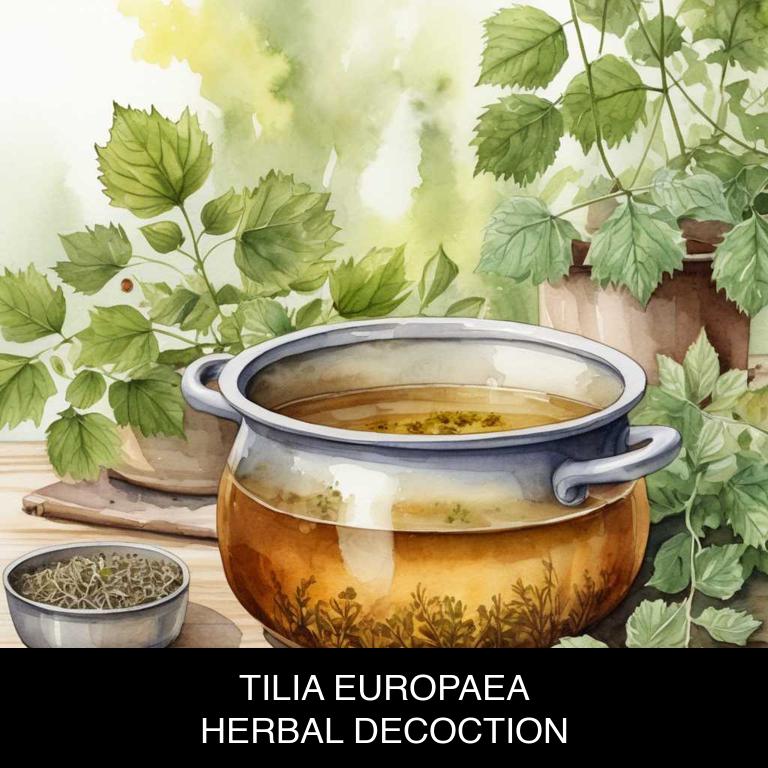
Medicinal Constituents
The list below shows the primary medicinal constituents in Tilia europaea decoctions that help with eye strain.
- Flavonoids: These compounds help alleviate eye strain by reducing inflammation and improving blood flow to the eyes, thereby promoting relaxation and reducing discomfort.
- Triterpenes: Triterpenes in Tilia europaea help reduce eye strain by exhibiting mild sedative properties, which can help calm the eyes and reduce fatigue.
- Phenolic acids: Chlorogenic acid in Tilia europaea decoctions may help alleviate eye strain by exerting antioxidant effects, reducing oxidative stress, and promoting overall eye health.
Parts Used
The list below shows the primary parts of lime used to make decoctions for eye strain.
- Leaves: The leaves are often used in decoctions due to their calming properties, which help to reduce eye strain and promote relaxation.
- Buds: The buds are used in decoctions to provide anti-inflammatory properties, which can help to alleviate eye strain and promote overall eye health.
- Flowers: The flowers are commonly used in decoctions for their soothing and calming effects, which can help to reduce eye strain and promote a sense of calmness.
Quick Recipe
The following recipe gives a procedure to make a basic lime for eye strain.
- Harvest 20-30 grams of dried flowers of tilia europaea from a trusted source on a sunny morning.
- Grind the harvested flowers into a fine powder using a mortar and pestle for 5 minutes.
- Combine the ground flowers with 1 liter of boiling water in a heat-resistant container for 5-7 minutes.
- Strain the decoction through a cheesecloth or a fine-mesh sieve into a clean container for 5 minutes.
- Store the filtered decoction in a cool dark place for up to 24 hours before consumption.
10. Achillea millefolium
Yarrow decoctions helps with eye strain because of its unique composition, which includes flavonoids, saponins, and alkaloids that possess anti-inflammatory and antioxidant properties.
These compounds help to reduce inflammation in the eyes, alleviating symptoms of eye strain such as dryness, irritation, and fatigue.
Additionally, yarrow's antioxidant properties protect the delicate tissues around the eyes from damage caused by excessive blue light exposure, promoting healthy vision and reducing the risk of age-related macular degeneration.

Medicinal Constituents
The list below shows the primary medicinal constituents in Achillea millefolium decoctions that help with eye strain.
- Caffeic acid phenethyl ester: This phenolic compound helps with eye strain by reducing inflammation and oxidative stress in the eyes, which can contribute to eye fatigue and discomfort.
- Apigenin: As a flavonoid, apigenin helps with eye strain by acting as a natural anti-inflammatory and antioxidant, which can help protect the eyes from damage caused by prolonged use of digital devices or other visual tasks.
- Β-caryophyllene: This sesquiterpene has anti-inflammatory properties that can help alleviate eye strain by reducing inflammation and promoting relaxation in the eye muscles, which can help alleviate eye fatigue and discomfort.
Parts Used
The list below shows the primary parts of yarrow used to make decoctions for eye strain.
- Leaves: The leaves are the most commonly used part of Achillea millefolium for decoctions due to their high concentration of flavonoids and sesquiterpenes, which have anti-inflammatory and antioxidant properties.
- Flowers: The flowers are used for their carotenoid and flavonoid content, which helps to reduce eye strain by protecting the eyes from oxidative damage.
- Roots: The roots contain a higher concentration of sesquiterpenes and flavonoids compared to other parts, making them effective in reducing inflammation and relieving eye strain.
Quick Recipe
The following recipe gives a procedure to make a basic yarrow for eye strain.
- Harvest 25-30 grams of fresh achillea millefolium leaves and flowers in the morning when they are at their highest potency.
- Rinse the harvested material with cold water to remove any dirt or debris and pat dry with paper towels.
- Steep 1 teaspoon of dried achillea millefolium in 1 cup of boiling water for 5-7 minutes to release active compounds.
- Strain the decoction through a cheesecloth or a fine-mesh sieve into a clean container to remove solids.
- Store the prepared decoction in the refrigerator for up to 2 days or freeze for later use in ice cube trays.
What is the best combination of herbal decoctions to use for eye strain?
The best combination of herbal decoctions that help with eye strain is a blend of eyebright, feverfew, and licorice root.
Eyebright is known for its anti-inflammatory properties, while feverfew helps to relax the muscles and reduce tension around the eyes. Licorice root provides a soothing and calming effect, reducing redness and puffiness.
Combining these three decoctions can help alleviate eye strain, promote relaxation, and support overall eye health, making them an effective natural remedy for those who spend extended periods in front of screens or engage in visually demanding activities.
What ailments similar to eye strain are treated with herbal decoctions?
Ailments similar to eye strain that are treated with herbal decoctions are headaches, migraines, and tension.
Herbalists often recommend decoctions of plants like feverfew, lavender, and peppermint to soothe these conditions. These herbs have anti-inflammatory and relaxing properties that can help relieve pain and reduce stress, promoting overall well-being.
By brewing a warm cup of herbal tea, individuals can find natural relief from discomfort and promote healthier habits.